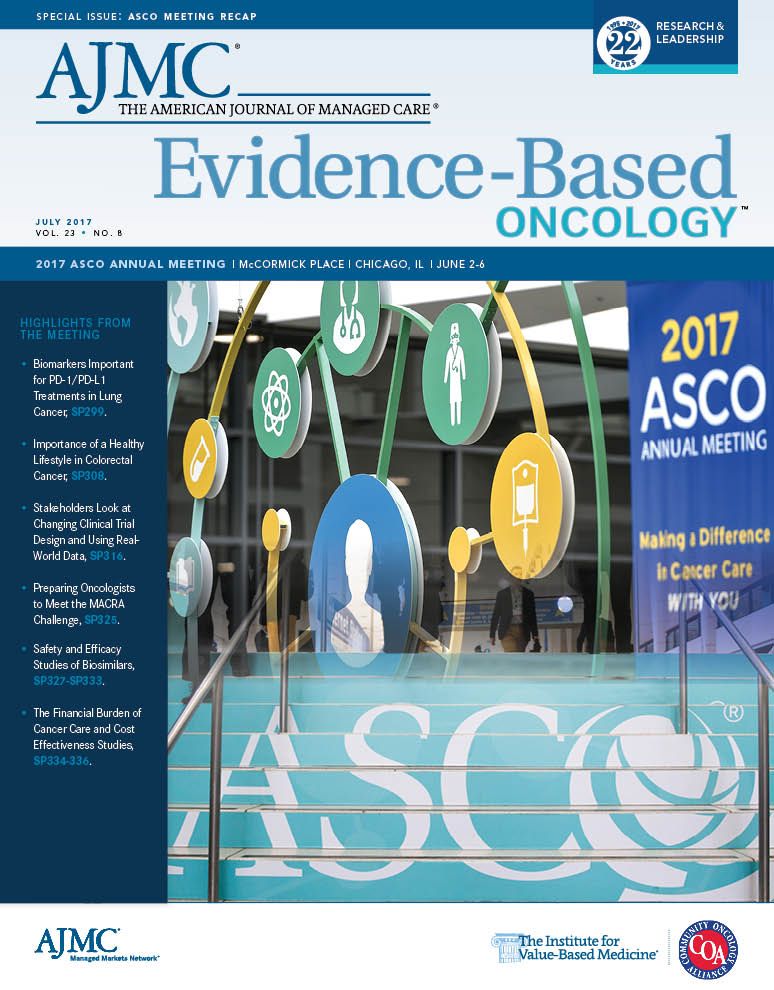Publication
Article
Evidence-Based Oncology
CT-P6, a Trastuzumab Biosimilar, Shares the Safety and Efficacy Profile of Its Reference
Author(s):
CT-P6, a proposed trastuzumab biosimilar, is safe and effective as a neoadjuvant treatment in HER2—positive early breast cancer, according to research presented at the 2017 American Society of Clinical Oncology Annual Meeting.
RESEARCH PRESENTED AT THE
2017 American Society of Clinical Oncology Annual Meeting shows that CT-P6, a proposed trastuzumab biosimilar, is safe and effective as a neoadjuvant treatment in human epidermal growth factor receptor 2—positive (HER2–positive) early breast cancer (EBC).
CT-P6, a recombinant humanized monoclonal antibody that targets HER2 that was approved by the Ministry of Food and Drug Safety, a government body in Korea, has an identical amino acid sequence and highly similar physicochemical and in vitro functional properties to trastuzumab. The results of a phase 1 trial demonstrated similar pharmacokinetics (PKs), safety, and immunogenicity between the 2 products.
This double-blind, randomized, phase 3 study sought to demonstrate the therapeutic response equivalence of CT-P6 and its reference product as determined by the pathological complete response (pCR), defined as the absence of invasive cancer in the breast and axillary nodes, irrespective of ductal carcinoma in situ. Secondary objectives for the study included obtaining additional PKs, pharmacodynamic, and safety data. The researchers also sought to evaluate additional efficacy parameters, including breast pCR (bpCR), defined as the absence of invasive cancer in the breast irrespective of ductal carcinoma in situ (DCIS) or nodal involvement; pCR without DCIS, defined as the absence of invasive cancer and in situ cancer in the breast and axillary nodes; overall response rate (ORR); and breast conservation rate.
The researchers considered 549 female patients 18 years or older who had been diagnosed with HER2—positive EBC of clinical stage I to IIIa. The patients had generally balanced demographics and disease characteristics, and were randomized at 112 centers in 22 countries. The 2 groups were treated with CT-P6 (n = 271) or the reference trastuzumab (n = 278) in combination with chemotherapy, as neoadjuvant treatment for 8 cycles, and for up to 1 year (or 10 cycles) of monotherapy as adjuvant treatment. Following neoadjuvant treatment, patients underwent surgery, at which point pathological response, PKs, and immunogenicity were assessed.
The predefined therapeutic equivalence margin for the risk ratio was 0.74 to 1.35, and the margin for the risk difference was —15% to 15%. The researchers found, with a 95% confidence interval, that the treatment risk ratio for the per-protocol set (PPS) was 0.93 (range, 0.78-1.11) and the treatment difference estimate for the PPS was –3.62% (range, –12.38% to 5.16%), both within the predefined equivalence margin. The proportion of pCR without DCIS, bpCR, and ORR were similar between the 2 treatment groups.
The study further found that serum concentrations of the treatment products, HER2-shed antigen levels, the proportion of patients who underwent breast conservation surgery, and rates of treatment-emergent adverse events (with neutropenia, anemia, and leukopenia being the most commonly reported adverse events) were similar for the 2 groups during the neoadjuvant period. None of the patients developed anti-drug antibodies during the study.
While adjuvant period data will be generated in the future, the researchers concluded that:
- CT-P6 was well tolerated.
- CT-P6 and trastuzumab are therapeutically equivalent in terms of pCR for both the PPS and the intent-to-treat set.
- CT-P6 and the reference product had similar safety profiles in the neoadjuvant period.
Secondary efficacy endpoints, as well as the results of PKs and pharmacodynamic analysis, further supported the similarity of the 2 products.REFERENCE
Stebbing J, Baranau YV, Baryash V, et al. Double-blind, randomized phase III study to compare the efficacy and safety of CT-P6, trastuzumab biosimilar candidate versus trastuzumab as neoadjuvant treatment in HER2 positive early breast cancer (EBC). J Clin Oncol. 2017;35(suppl; abst 510).

2 Commerce Drive
Suite 100
Cranbury, NJ 08512
© 2025 MJH Life Sciences® and AJMC®.
All rights reserved.





